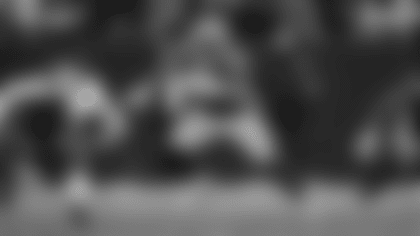Ask any player, and he won't hesitate to confirm the monotony of position drills during training camp.
Pushing the blocking sled, high-stepping through ropes, and drilling footwork and form are all necessary evils in an effort to prepare for the rigors of an NFL season.
But if there's one drill that generates some excitement, or at least isn't dreaded as much as the others, it's the one-on-one pass rush/protection drill between defensive and offensive linemen. The competition can get pretty spirited for reasons that go beyond player evaluation.
"I think it's pride," offensive coordinator Jeff Jagodzinski said. "You're out there on your own. It's either you or him, so you've got to show what you can do. Every snap becomes a one-on-one, especially pass pro(tection), so it shows up because it's right there in front of you. You can't hide, you can't run."
In one-on-ones, a lineman lines up across from another (defensive tackles get matched with guards and centers, defensive ends with offensive tackles, etc.) with a flag placed 5 to 7 yards in the backfield to represent the quarterback.
The defensive player's objective is to get the flag, and he'll try to run around, run through, or dive for it, any method he sees fit. The offensive player has to stop him, whatever it takes. And everybody is watching.
"If you win you love it, and if you lose you hate it," defensive end Aaron Kampman said. "It's a good drill. It really isolates you, so it's a good chance to put pressure on yourself."
In addition to being evaluated, and subsequently scrutinized on film in meetings, players on both sides also use one-on-ones to work on new moves or perfect their old reliables.
Sometimes players switch up whom they go against, but based on the starting lineup and a player's longevity, some matchups can carry on for years.
Kampman, a fifth-year left end, and Mark Tauscher, a seventh-year right tackle, have gone one-on-one more times than either cares to count. Same with Kabeer Gbaja-Biamila and Chad Clifton, though not as much this year because Clifton has missed several practices with a sore knee.
The players say they don't keep score, but even if they don't say so they're aware who has had the upper hand of late.
"Some days he gets me, some days I get him," Tauscher said. "It's good. We're both similar, hard-working guys that put forth a lot of effort. Both of us like to keep that as our trademark. We both want to work incredibly hard to try to make each other better."
That level-headed, productive approach doesn't always carry the day, though. In one drill early in camp, defensive end Jason Hunter and William Whitticker were so fiercely locked up that Whitticker's helmet was knocked off and the two just kept battling.
Another time, Hunter lost his helmet in a good scrum with Todd Williams. Cooler heads prevailed in both instances, but they can escalate to extra-curriculars at times.
"I'll be willing to bet you in the next three or four days you'll see a fight," Tauscher said. "It gets intense and gets heated. You get sick and tired of going against the same guy, and if somebody gets beat a couple times they get irritated, and if they get beat again they'll fight or throw a cheap shot, so that's where the heated stuff comes from.
"That's one-on-one competition, and I think that's where your flaws get exposed."
At times the drill morphs into two-on-twos, with defensive linemen running stunts and the offensive linemen having to react and adjust. But while that's a good look at skill and technique, it doesn't measure the attitude and fortitude that players, particularly young ones, hope to impress upon the coaches and potential future teammates in one-on-ones.
"You do anything you know how to do to win, that's basically how it goes," second-year tackle/guard Junius Coston said. "Definitely you go all-out. This is evaluation, this is training camp, when you're one-on-one they want to see what you've got. So you definitely have to pull out all the stops."














